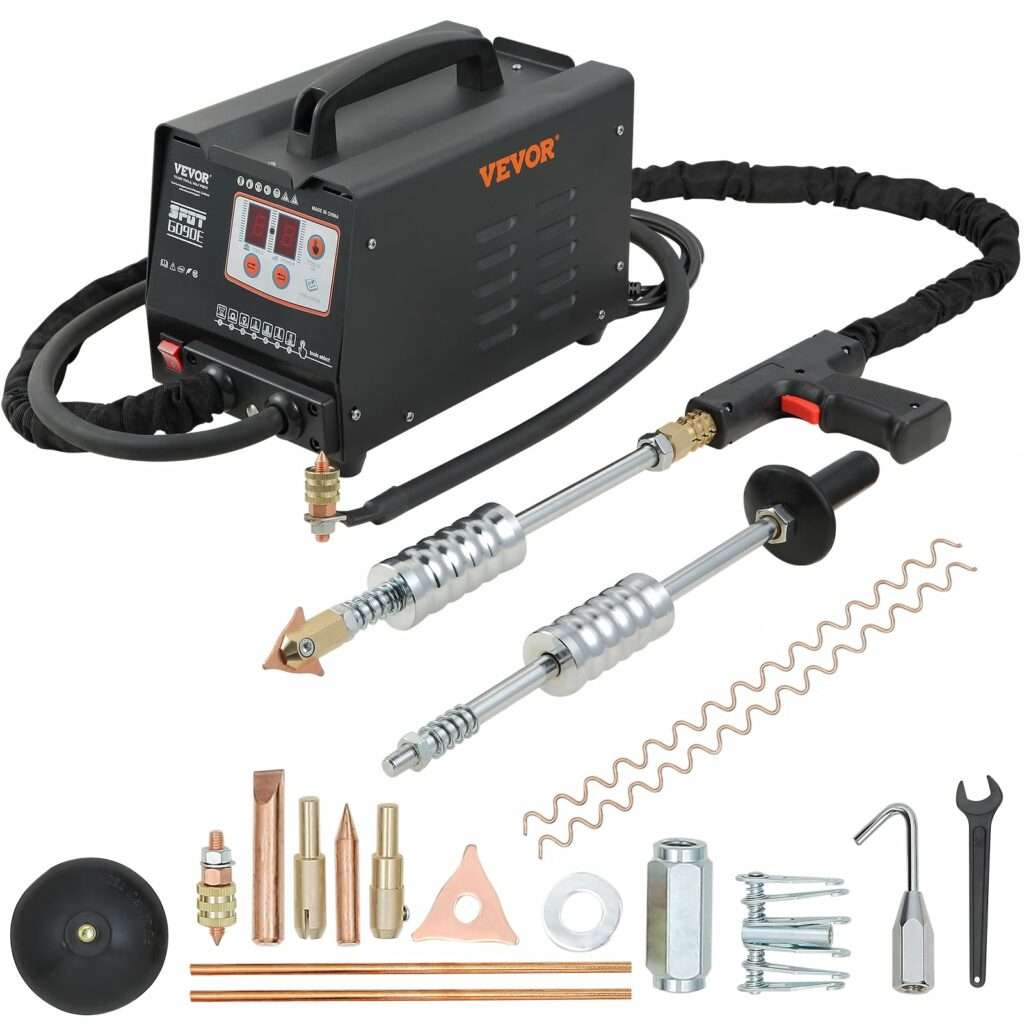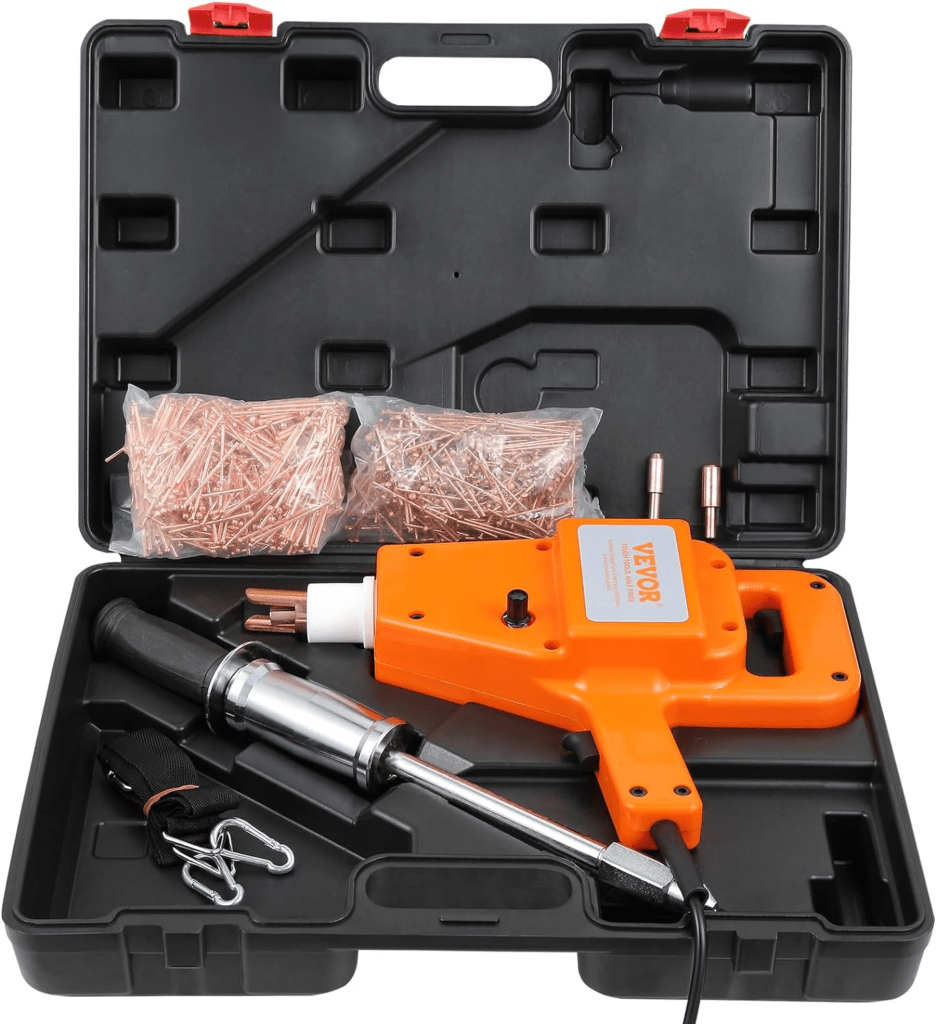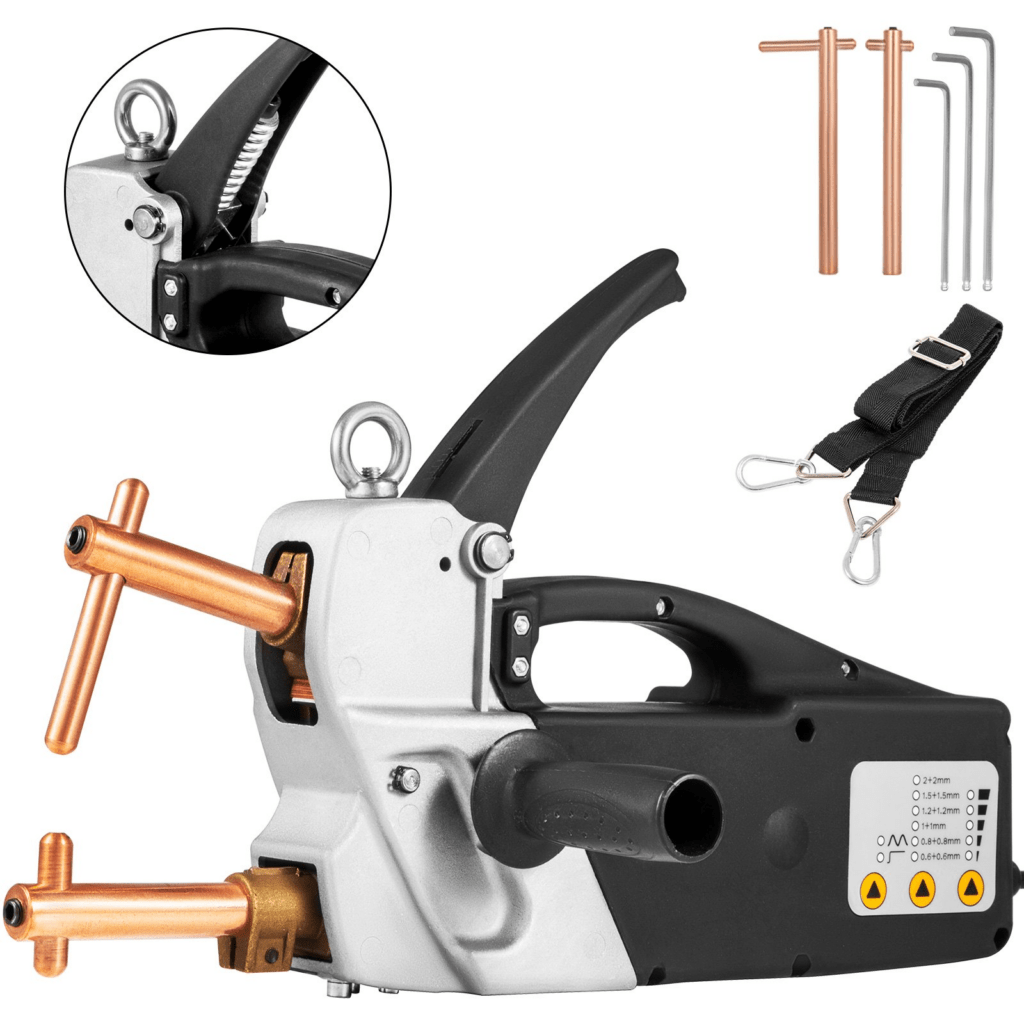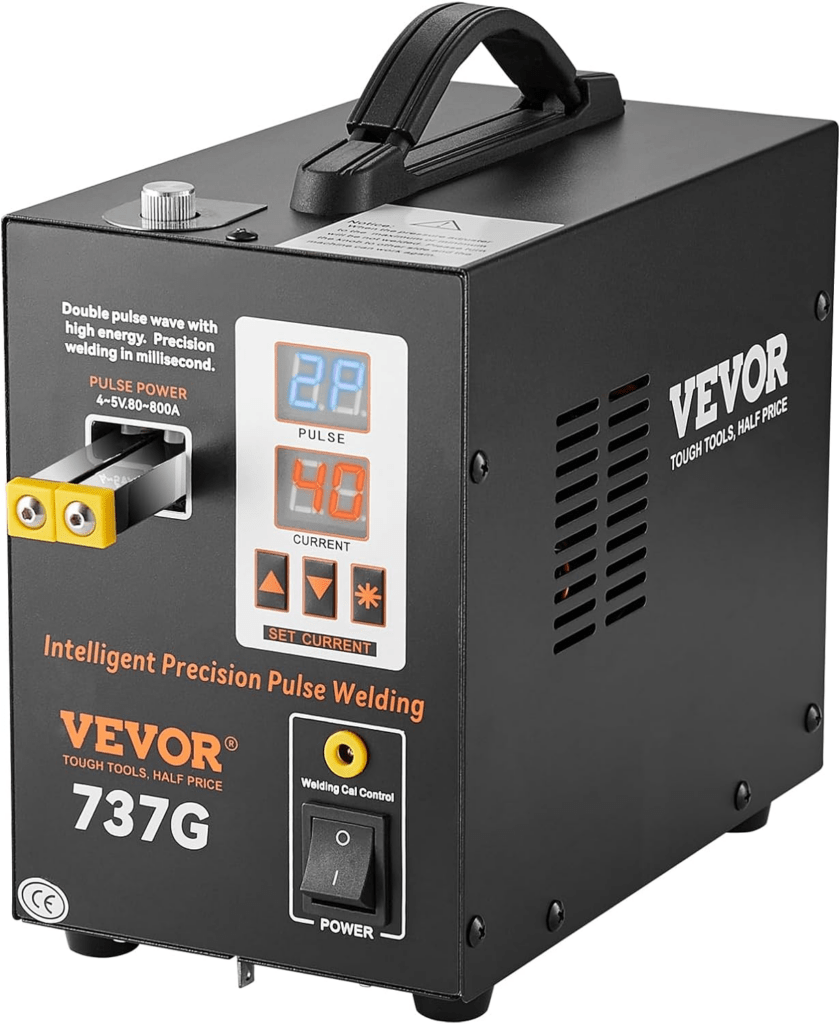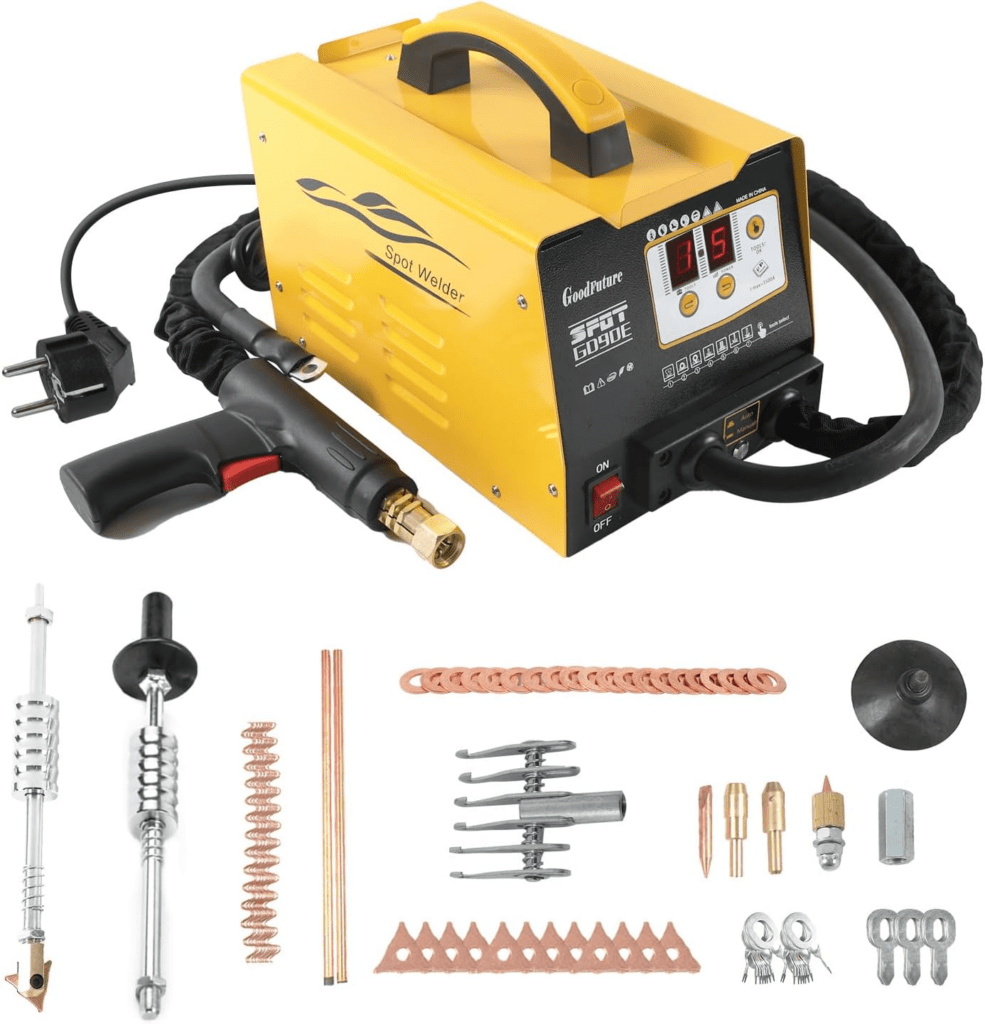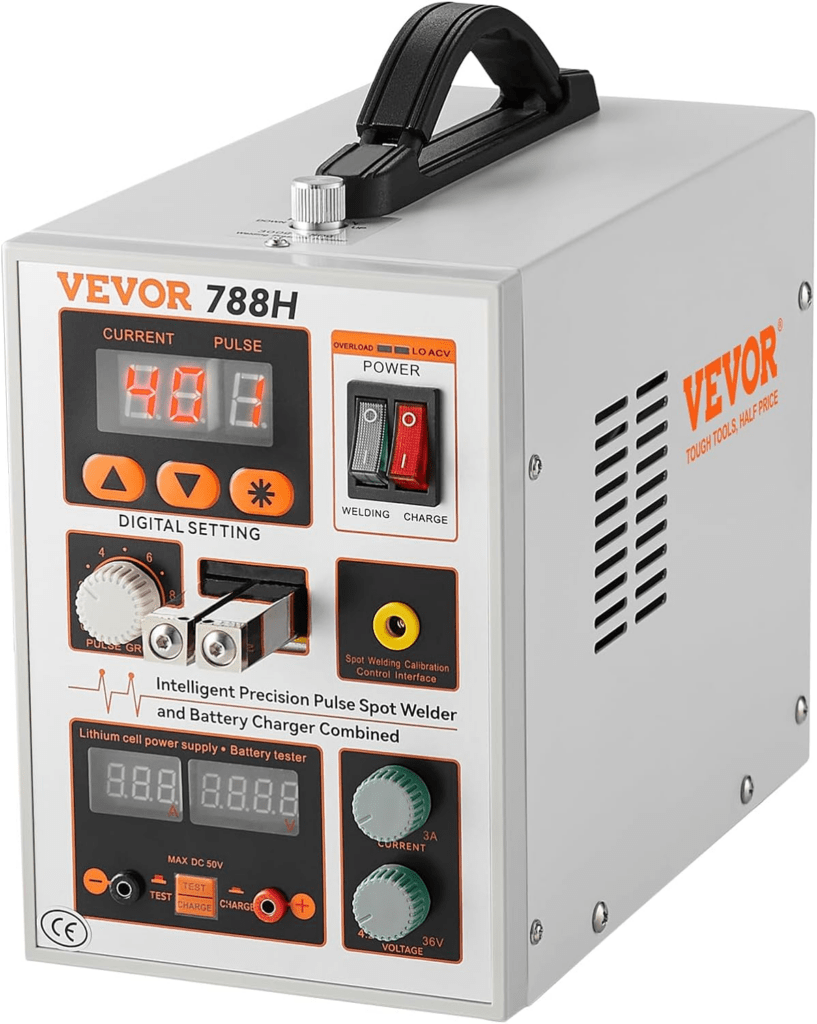A ‘battery welder’ or ‘welder points for battery’ is a manufacturing equipment of battery. It is designed to assemble batteries from lithium cells. One soda slats conductive between the cells in order to establish a network serial or parallel.
This tool is essential to perform welds by points specific to constitute batteries from e lithium cells.
The term ‘battery welder’ in american English translates to ‘welder points for battery’ in French.
SPOT WELDING
DENT PULLER
EXTRACTOR
BATTERY SPOT WELDER
INTERNATIONAL STOCK
Trusted and verified affiliate AliExpress links
Presentation of the battery welder
Definition and function
Definition :
A battery welder (or welding of batteries) is a specialized device used for welding of battery cells together, generally using the method of spot welding. This tool is essential to assemble battery packs securely and reliably, ensuring that electrical connections are solid and durable between the cells.
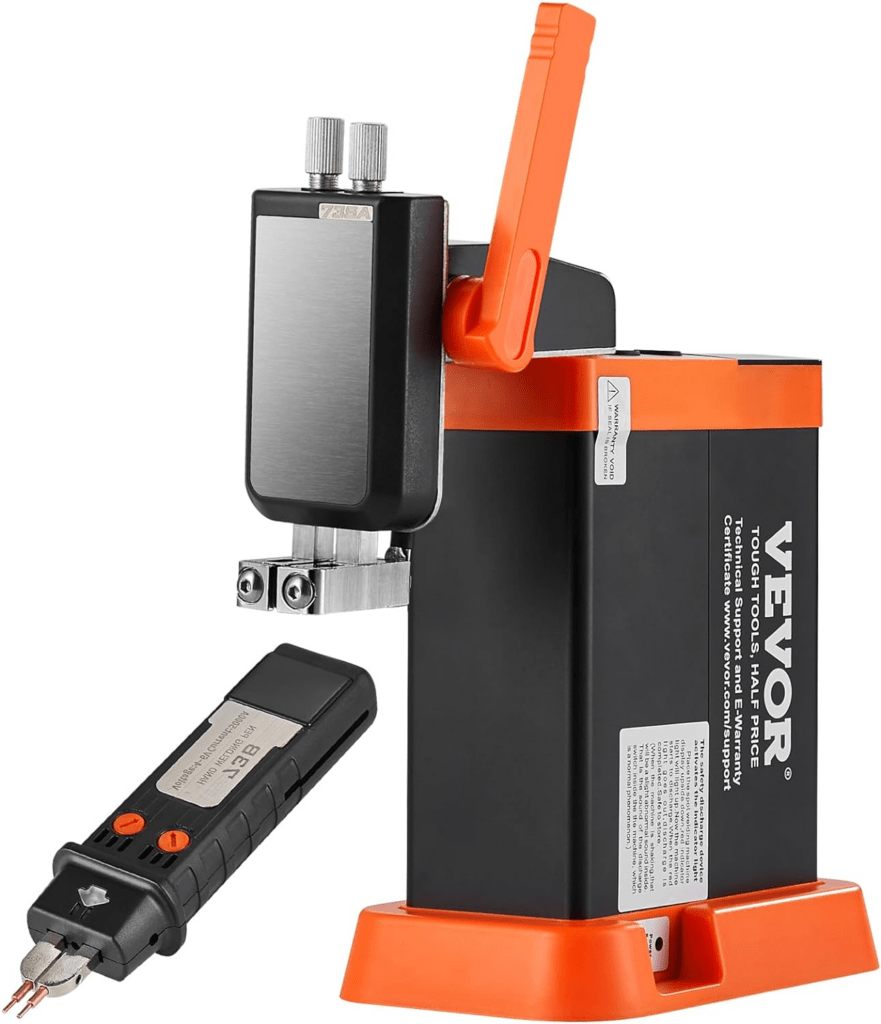
The spot welding for batteries is to apply an electrical impulse through the electrode to heat locally the metal tabs (often nickel) and the terminals of the cells, the merging as well. The battery welder is designed to provide precise adjustments of power and duration of welding, allowing the sto adapt to the different thicknesses of materials and the specifications of the battery cells.
The main components ofa battery welder :
- Welding Electrodes : That transfer electrical current to perform welding.
- The Power Controller : adjusts the amount ofenergy delivered during welding.
- The Media of Cells : To maintain the cells in position during the welding process.
- Security Mechanisms : Such as sensors and protections to prevent overloads and crashes.
Operation :
A battery welder, or welding of batteries, works by using the process of spot welding to assemble the battery cells to more effectively and securely. Here’s a detailed explanation of its operation :
Preparation of Cells and Tabs :
Verification of Cells : Each cell of the battery is checked with thehelp ofa multimeter toensure thatit is at the same voltage as the other, in order toavoid imbalances.
Arrangement of the Cells : The cells are placed in a holder which holds them in position during the welding process. They can be arranged in series, in parallel, or in a combined configuration, according to the specifications of the battery.
Preparation of the Tabs in Nickel : The tabs of metal, usually nickel, are cut to the proper size to connect the terminals of the cells. They are cleaned to ensure a good electrical conductivity.
Adjusting the Position of Welding :
Power setting : The power level of the welder is adjusted according to thethickness of the tabs and terminals of the cells. An adequate power is essential to avoid overheating ordamage to the cells.
Setting the Weld Time : The duration of thepulse welding is set to control the time during which the current is applied. This is toensure that the fusion of the materials is done in an optimal manner.
Welding process :
Positioning of the Electrodes : the electrodes of The welder are aligned with the tab on the nickel and the terminals of the cells. The actuator must be in contact with the terminals of a precise manner.
Application of thePulse Welding : An electrical pulse is sent through the electrodes, generating intense heat to thelocation of the contact. This heat melts locally, the tongue and the terminals of the cells, the merging together.
Verification of Welding : After each weld, theoperator verifies visually and mechanically the strength of the connection. Itensures thatthereare no solder points weak or burns excessive.
Finalization and Testing :
Final assembly : The tabs are welded according to the schema you want to connect (serial or parallel). The final connections are insulated to prevent short circuits.
Battery Test : A multimeter is used to check the overall voltage of the battery pack assembled. Tests of charge and discharge can be made toensure that the battery is working properly.
Security and Maintenance :
Protective equipment : operators must wear personal protective equipment (heat-resistant gloves, safety goggles) to avoid injury caused by the sparks and heat.
Maintenance : The battery welder must be regularly maintained, including the cleaning of the electrodes and the verification of the electrical connections to ensure optimum performance and extend the life of thedevice.
The main Applications of the battery welder :
The battery welders or welding of batteries, are essential tools for various industries where theassembly of battery packs is crucial. Here are the main applications for these devices :
The assembly of Battery Packs, Lithium-Ion (Li-ion) :
Used in portable electronic devices such as smartphones, tablets, and laptops.
Also used in portable power tools such as drills, saws, and other tools wireless.
Nickel-Metal Hydride Batteries (NiMH) : Used in household appliances like vacuum cleaners, wireless, electric toothbrushes and shavers.
Also used in certain industrial applications that require rechargeable batteries.
Lithium-Polymer (Li-Po) : Frequently used in drones, scale models ofaircraft and radio controlled vehicles because of their light weight and their high capacity.
Electric and Hybrid vehicles :
Electric cars (EV) : The battery welders are used to assemble the modules of batteries that power electric vehicles, providing a source ofreliable and sustainable energy.
Hybrid vehicles (HEV) : the Assembly of battery packs used to provide power assistance to the internal combustion engine, thus improving theoverall energy efficiency.
Bicycles and Electric Scooters : Creation of battery packs compact and powerful to power electric vehicles, and personal.
Renewable energy and storage systems ofenergy :
Manufacture of batteries for the storage systems ofenergy for domestic and industrial, to store theenergy produced by the solar panels and wind turbines.
Use in micro-networks to stabilize theenergy supply, and improve the resilience of electricity networks.
Medical Equipment :
Medical devices Mobile : for Use in the hand-held medical equipment such as heart monitors, insulin pumps and other devices requiring a source ofreliable energy.
Carts Medical : battery Assembly for carts medical use in hospitals, ensuring a continuous power supply for medical equipment reviews.
Home appliances and Consumer Products :
Wireless tools : Manufacturing of battery packs for a variety ofcordless tools that are used in domestic applications and professional.
Appliances : Assembly of batteries for household appliances portable, such as a vacuum cleaner wireless, electric toothbrushes and lawn mowers.
Industrial Applications
Robots and Automation : Create battery packs for industrial robots and automated systems, providing a source ofreliable power for continuous operations.
Systems ofPower Interruptible (UPS) : Manufacture of batteries for the UPS, thus ensuring a backup power supply in case of power loss to critical equipment.
Advantages of the battery welder :
Theuse ofa battery welder has many advantages compared toother welding processes to thebattery assembly. Here are the main advantages :
1. Accuracy and Quality of Welds
- Precise control of the Power :
- The battery welders allow for a very precise control of the power and the duration of thepulse welding. This ensures that welds consistent and of high quality, critical for the reliability of battery packs.
- Welds Own :
- The spot welding creates welds own with little projections, reducing the need for cleaning after the soldering process.
2. Speed and Efficiency
- Quick Process :
- The spot welding is a process that is fast, able to perform welds in a few milliseconds, which significantly accelerates the time of production.
- Automation :
- The battery welders can be easily integrated in automated systems, increasing productivity and reducing labour costs ofimplementation.
3. Reduction of the Labour Costs ofWork and Materials
- Less Materials Needed :
- Compared toother methods, the spot welding, uses less materials dintake, thereby reducing the costs of production.
- Waste reduction :
- Minimizing the projections and the waste of solder the battery welders contribute to a more efficient use of materials.
4. Security and the Improvement of Working Conditions
- Less Fumes and Gases :
- The spot welding generates less smoke and gas pollutants thanother welding processes, thus improving the quality of theair in theworkshop and reducing the health risks for the operators.
- Reduction of the Risk of Burns and ofelectric Shock :
- The battery welders are designed to be safe to use, with built-in protection systems to prevent accidents related to burns and electric shock.
5. Durability and Reliability of the Welds
- Strong Connections :
- Spot welds are strong. They provide strong connections. They are resistant to vibrations and shocks. They are suitable for applications in mobile and industrial applications.
- Low Risk of Overheating of the Cells :
- By precisely controlling theenergy applied, the battery welders minimize the risk of overheating of the battery cells, thus preserving their integrity and long-term performance.
6. Flexibility and Adaptability
- Wide Range of Materials and ofThicknesses :
- The battery welders can weld a variety of materials and ofthicknesses, including the tabs in nickel, copper and aluminum, thus offering a great flexibility for different applications.
- Compatibility with Various Types of Batteries :
- Thatit’seither lithium ion, nickel-metal hydride batteries or other types of cells rechargeable batteries, the battery welders are suitable for a variety of battery configurations.
The battery welders are distinguished by their precision, their speed, their safety and their effectiveness, which makes it thetool of choice for theassembly of battery packs. Their ability to create welds clean and solid, to reduce the costs of materials and labourwork, and to offer flexibility in applications makes them indispensable in many industries, ranging fromconsumer electronics to electric vehicles, and to systems of storage ofenergy.
Choosing the right battery welder :
Factors to consider : budget, applications, features, technologies.
At the time of thepurchase ofa battery welder, it is essential to take into account multiple factors toensure that theequipment will meet specific needs. Here are the main criteria to consider : the budget, the intended applications and technical specifications.
Budget
- Initial Cost :
- The cost ofa battery welder can vary greatly depending on the brand, model and features included. Set a realistic budget, taking into account the immediate needs of your workshop and the cost ofthe initial investment. The high-end models often offer advanced features that can justify a higher cost.
- Long-Term cost :
- In addition to the initial cost, consider the maintenance costs, supplies, and training equipment. A model that is more expensive but of higher quality can reduce the cost of maintenance in the long term and offer increased durability, this is a wise investment.
Technical characteristics
- Power and Ability :
- The power of the battery welder determines its ability to solder the cells on different thicknesses of metal. Choose a model with a power adapted to your needs. A model with a variable power can offer more flexibility for different types of mounts.
- Controls & Adjustments :
- The ability to adjust the power, time and pressure is crucial to perform constructions accurate. Make sure that the battery welder offers easy settings to use to adjust the weld to different situations.
- Ease ofUse :
- A battery welder easy to use, increases theefficiency and reduces the training time needed. Look for models with user interfaces that are intuitive and user-friendly features.
- Portability :
- Portability may be an important factor, especially if you have to move theequipment between different work stations or sites. The portable models offer additional flexibility, while stationary models can offer more power and durability.
- Durability and Reliability :
- The sturdy construction and high-quality materials guarantee a long service life of theequipment. Check the reviews and recommendations of users to assess the reliability of the model that you are considering.
- Safety :
- The characteristics of security, such as protection devices against overvoltage and security thermal imaging, are essential to prevent accidents. Make sure that the model you choose is consistent with the safety standards, and includes features robust security.
- Accessories and Consumables :
- The available accessories, such as various types of plates and the welding electrodes can improve theeffectiveness and versatility of your battery welder. Opt for a model that is compatible with a wide range ofaccessories and consumables that are easily available.
Technical choices
The choice ofa battery welder suited to your needs depends on a careful evaluation of several key factors : the budget, the intended applications and technical specifications. By taking the time to consider each aspect, you can ensure that theequipment you choose not only meet your current requirements, but alsoadapt to the future needs of your workshop.
Invest in a battery welder quality can transform theefficiency and accuracy of your assemblies, while reducing long-term costs and improving the safety of your workshop. Whether you’re a manufacturing workshop of high-volume or an experienced independent, choosing the right battery welder is a strategic decision that will impact the overall performance of your business.
Comparison of different types of battery welders available on the market (portable, stationary, etc).
The choice ofa battery welder depends on several factors such as theintended application, the frequency ofuse, budget, and technical requirements. The battery welders are classified mainly into three categories : portable, stationary, and robotic. Here’s an exhaustive comparison of these types of battery welders.
1. Battery welders portable
Description : The battery welders, portable compact and lightweight. It is easily transportable. They agree to repair mobile or workshops where space is limited.
Features :
- Portability : Easy to carry, perfect for on-site repair.
- Power : Typically less powerful than stationary models, but sufficient for most repairs of thin-to medium-sized.
- Use : easy to use with a quick learning curve.
- Applications : Repairs dents, fixing of light weight panels, use in tight spaces.
Benefits :
- Mobility : Ideal for technicians who are working on different sites.
- Cost : Often less expensive than stationary models and robotic.
- Installation : Requires minimal setup and configuration.
Disadvantages :
- Power Limited : Less adapted to work a heavy or thick materials.
- Durability : Less robust for intensive use in relation to models of stationary.
2. Battery welders stationary
Description : The battery welders, stationary fixed machines installed in a workshop. They offer more power and advanced features, suitable for heavy work and heavy usage.
Features :
- Power : Higher, capable of processing thicker materials.
- Stability : Mounted in a fixed manner, which allows for the use of more stable and continuous.
- Use : advanced user Interface with precise adjustments for different types of materials, and nails.
- Applications : emergency Repairs, series production, structural reinforcement, fixing components are heavy.
Benefits :
- Performance : More powerful and suitable for a wide range of tasks.
- Durability : Designed for intensive use and long lasting.
- Features : advanced Options such as digital control, memory settings, etc
Disadvantages :
- Mobility : Non-transportable, limited to a fixed location.
- Cost : More expensive than portable models.
3. Battery welders robotic
Description : The battery welders robot’sintegration into automated systems. They are suitable for industrial applications on a large scale. Theyuse within the production chain are automated.
Features :
- Automation : Controlled by robots, which allows operations without human intervention.
- Accuracy : Extremely accurate with automatic settings for a wide variety of tasks.
- Use : advanced Programming for cycles of welding repeated and consistent.
- Applications : series Production, industries requiring high precision and high efficiency, such as automotive and aerospace.
Benefits :
- Efficiency : High-efficiency and productivity through automation.
- Quality : Welds of consistent and high quality with consistent accuracy.
- Safety : Less risk for the operators thanks to the full automation.
Disadvantages :
- Cost : Very expensive initial investment and high maintenance costs.
- Complexity : Installation and programming complex, require specialized training.
Comparison of Key Factors
| Critère | Portables | Stationnaires | Robotisés |
|---|---|---|---|
| Portability | Very high, easy to carry | Low, fixed in a place | Null, integrated systems stationary |
| Power | Moderate, suitable for light-weight materials to medium | High, suitable to a wide range of materials and tasks | Very high, suitable for heavy duty industrial applications |
| Ease of use | Easy, quick learning | Average, requires an initial training | Complex, requires programming and advanced training |
| Applications | Repairs lightweight, mobile use | Repair lourdes, series production, heavy use | Series Production, industrial applications of automated |
| Cost | Low to moderate | Moderate to high | Very high |
| Sustainability | Modérée | High, designed for intensive use | Very high, designed for continuous production |
| Advanced features | Limitées | Advanced, with options for digital control | Very advanced, full integration with production systems, automated |
The choice of a battery welder will mainly depend on your specific needs, your budget, and the work environment. For repairs of mobile and workshops with limited space, a battery welder portable is ideal. If you need more power and durability for intensive work, a steady-state pattern is more appropriate. Finally, for industrial applications, large-scale, requiring a production in series, the battery welders robotic offer an optimal solution in spite of their high cost and complexity.
In assessing carefully these criteria, and understanding the advantages and disadvantages of each type of battery welder, you will be able to make an informed choice that will maximize theefficiency and profitability of your workshop.
Tips foruse ofa battery welder
Theuse ofa battery welder (spot welder battery) requires precautions, and specific methods to ensure safe and efficient operation. Here are a few tips for maximizing the performance and safety during theuse of this type ofequipment.
Preparation and Safety
Personal Protective equipment (PPE) :
Safety goggles : To protect your eyes from sparks and debris.
Heat resistant gloves : protect your hands from burns.
Protective clothing : Wear fire retardant clothing to prevent burns.
Safety shoes : Use shoes with insulating soles to reduce the risk of electric shock.
Preparation of the Work Area :
Clean and tidy area : Make sure that the work area is clean and free of flammable materials.
Ventilation : good ventilation is necessary to prevent theaccumulation of fumes and gases that are potentially harmful.
InspectionEquipment :
Checking connections : Make sure all electrical connections are tight and in good condition.
All cables : Inspect the cables to detect any wear or damage.
Batteries : Check the charge level and thecondition of the batteries. Replace the batteries are damaged or worn.
Settings and Adjustments
Selection of the correct Power :
Material Type : Adjust the power as a function of thethickness and type of material to be welded. A power too high can burn the metal, whereasan insufficient power can lead to weld low.
Preliminary tests : Perform tests on pieces of scrap to properly adjust the power before working on the final piece.
Setting the Duration of Welding : welding Time optimal : Adjust the duration of the welding to ensure a merger adequate without overheating the metal.
Pressure Welding :
Uniform pressure : Apply a uniform pressure to avoid welds on uneven or weak.
Maintenance and Servicing
Ensure maintenance and regular maintenance of your battery welder (spot welder battery) is essential to ensure its proper operation, prolonging its life and preventing breakdowns. Here is a detailed guide on the steps and recommended practices for themaintenance of this equipment.
Regular Inspection
Visual Inspection :
Cables and Connectors : regularly Check thecondition of the cables and connectors to detect any wear, cuts or damage. Replace damaged cables immediately.
Housing of theDevice : Inspect the enclosure to verify thatthereare no cracks, damage or signs ofwear.
Electrodes : Look at the electrodes and see if they are clean and in good condition. Replace if they are worn or damaged.
Nettoyage
Cleaning the Components :
Electrodes : Clean the electrode after each use to remove any excess solder. Use a wire brush or a cloth sec.
Ventilation : Make sure that the ventilation holes are not obstructed by dust or debris. Use thecompressed air to clean them if necessary.
External Surfaces : Wipe the external surfaces of theappliance with a damp cloth. Never use aggressive solvents that might damage the components.
Preventive Maintenance
Checking Connections :
Tightness of Connections : Check all electrical connections are tight to avoid false contacts or short-circuits.
Battery status : Check regularly thecondition of the batteries. Replace the batteries that show signs of failure, swelling or leakage.
Calibration and Adjustments :
Calibration Settings : Make sure the power parameters and weld time are properly calibrated. Please refer to the manual of theuser to the specifications of calibration.
Software Update :
If your device is equipped witha software, regularly check the updates proposed by the manufacturer and install them.
Stockage
Storage Conditions :
Dry environment : Store thedevice in a dry place to avoid the corrosion of the electrical components.
Temperature-Controlled : Avoid storing thecamera in places where the temperature is extremely high or low.
Protect Against Shock : Keep thedevice in a location where there is no risk ofbeing struck or damaged byother objects.
Documentation and Follow-up
Service log :
A record of the Inspections : Keep a log of the inspections and maintenance work. Note the dates, observations and actions taken.
Follow-up Problems :
Document the problems and solutions to facilitate the diagnosis and the resolution of future problems.
References to the Manual :
Always refer to the manual ofuse provided by the manufacturer for specific instructions on maintenance and repairs. Follow the manufacturer’s recommendations to ensure compliance and safety.
Training and Awareness
User training :
Correct use : Make sure that all users of thedevice are trained in its proper use, and to the realization of tasks of basic maintenance.
Security awareness :
Put theemphasis on theimportance of security practices and theuse of thepersonal protective equipment (PPE).
By following these tips for maintenance and dmaintenance, you can ensure a reliable operation and secure your battery welder. A regular inspection, cleaning, appropriate, audits, preventive, proper storage and a rigorous documentation help to extend the life of thedevice and prevent costly breakdowns.
Glossaire
A
Amperage (Amps) : measurement of the amount of electric current passing through a circuit, which is crucial to determine the welding power.
Anode : Thepositive electrode in an electrical circuit.
B
Battery spot welder (Welder by Points with Battery) : A device used for welding of metallic materials using theenergy stored in a battery, often used to assemble the battery packs and sheet metal.
Pin (Stud) : A metal rod used in the process of welding to fasten metal parts together.
C
Cathode : Thenegative electrode in an electrical circuit.
Ground cable : A cable that connects thedevice for welding the work piece to complete the electrical circuit.
Connector : A device used to connect the welding cables to thedevice or the workpiece.
D
Duration of sSoudage : the time during which The welding current is applied to complete the weld.
E
Electrode : A conductor through which the current enters or leaves in the welding process.
Electrolyte : A substance that conducts theelectricity in batteries, often a liquid solution or gel.
Personal protective equipment (PPE) : equipment such as gloves, safety glasses, and clothes that are resistant to the heat used to protect the operator during the welding.
F
Fusion : The process of fusion of materials to their surfaces of contact to form a strong bond after cooling.
G
Template : A tool used to ensure accurate placement and consistent welds or pins.
I
Current intensity : a measure of The amount of electric charge passing through the welding circuit per unit of time, often measured in amperes.
M
Preventive Maintenance : The regular procedures ofinspection, cleaning and verification to ensure the proper operation of thewelding equipment.
Manuel dutilisation : A guide provided by the manufacturer that contains the instructions for theuse andmaintenance ofwelding equipment.
P
Welding parameters : The settings of the welding device, such as the power and duration of welding, adjusted according to the specifications of the material to be welded.
Scope of welding : the ability of Thewelding device, to achieve and to weld different parts of the work piece.
Heartbeat : A technique of welding in which the current is applied in fast pulses to control the amount of heat and fusion.
R
Power adjustment : Theadjustment of the level of electric current supplied by thewelding unit to obtain an optimal brazing.
S
Electrical safety : practices and measures to prevent electric shock during theuse of thewelding equipment.
Welding : The process of fusion of two materials of metal to create a permanent bond.
Surface of tfocus : Cis the area on which the welding is carried out. It must be clean and well prepared to ensure high quality welds.
T
Technician welding : A person trained and qualified to perform welding operations.
V
Ventilation : The process of providing a stream ofair adequate to remove the fumes and noxious gases are produced during welding.
Voltage (Voltage) : Cis the difference of electrical potential between two points in a circuit. It determines the force with which the electric current is pushed through the circuit.




